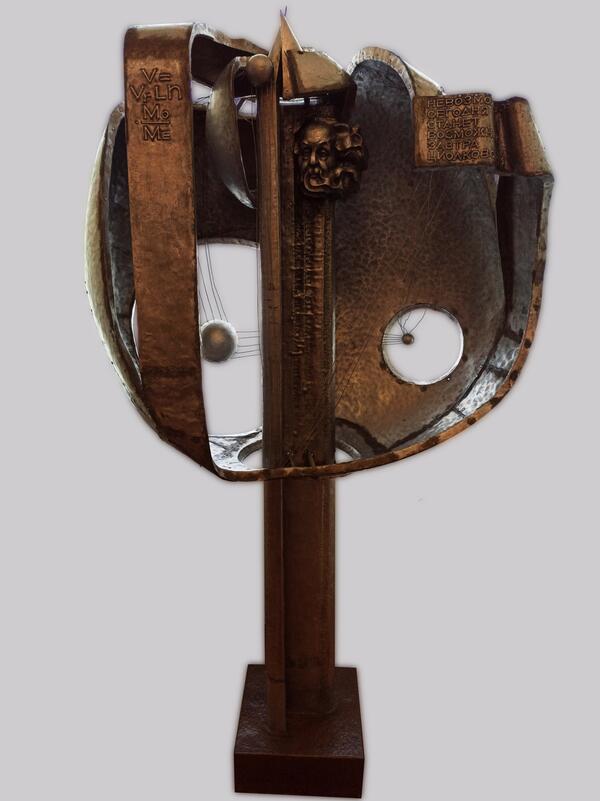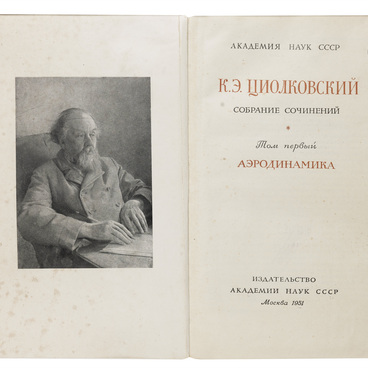In 1977, Tsiolkovsky Museum moved into a new building. Ryazan artist Vladimir Shipov, who donated to the museum a sculptural composition ‘The Tsiolkovsky Equation’, worked on its display and design of its spaces.
The composition is based on the most important philosophical idea of Konstantin Tsiolkovsky, which states that man is an organic part of the universe, and space itself acts as ‘the world of man’. Tsiolkovsky sees the universe as a single, complex mechanism infinite in space and time, having its own ‘Cause’ and ‘Will’ -- some higher intelligence, regulating relations in the universe.
‘The fate of a living being depends on the fate of the Universe’ - wrote Tsiolkovsky, pointing to the inextricable connection of life on Earth with space objects and matter. According to the scientist, everything in the universe aspires to monism, that is, to a single elementary beginning.
Unity is also at the heart of Tsiolkovsky’s theory of atoms, which states that every atom in the universe moves and transforms continuously and that this process never stops.
The scientist believed that our entire world could be explained from a cosmic perspective and saw the future of mankind in space exploration. He predicted that in the future humanity would have to survive the depletion of Earth’s resources and the cooling of the sun. Therefore, the main priority was the continuous development and improvement of the individual and society.
In the sculptural composition of Vladimir Shipov, the sphere symbolizes the universe with its holes and emptiness. Inside it, thin, almost invisible strings connect smaller spheres. They represent stars and planets, which in turn are connected to the mind of man. It is embodied in the sculpture by a bas-relief depicting Konstantin Tsiolkovsky, the founder of theoretical cosmonautics. The face of the scientist is strict and majestic, his hair is flowing, as if in the wind of unknown distant planets that one day humans will reach.
The composition is based on the most important philosophical idea of Konstantin Tsiolkovsky, which states that man is an organic part of the universe, and space itself acts as ‘the world of man’. Tsiolkovsky sees the universe as a single, complex mechanism infinite in space and time, having its own ‘Cause’ and ‘Will’ -- some higher intelligence, regulating relations in the universe.
‘The fate of a living being depends on the fate of the Universe’ - wrote Tsiolkovsky, pointing to the inextricable connection of life on Earth with space objects and matter. According to the scientist, everything in the universe aspires to monism, that is, to a single elementary beginning.
Unity is also at the heart of Tsiolkovsky’s theory of atoms, which states that every atom in the universe moves and transforms continuously and that this process never stops.
The scientist believed that our entire world could be explained from a cosmic perspective and saw the future of mankind in space exploration. He predicted that in the future humanity would have to survive the depletion of Earth’s resources and the cooling of the sun. Therefore, the main priority was the continuous development and improvement of the individual and society.
In the sculptural composition of Vladimir Shipov, the sphere symbolizes the universe with its holes and emptiness. Inside it, thin, almost invisible strings connect smaller spheres. They represent stars and planets, which in turn are connected to the mind of man. It is embodied in the sculpture by a bas-relief depicting Konstantin Tsiolkovsky, the founder of theoretical cosmonautics. The face of the scientist is strict and majestic, his hair is flowing, as if in the wind of unknown distant planets that one day humans will reach.
And near the bas-relief, there are stylized arrows, symbolizing the rockets lifting off, ready to go into the infinite expanse of the universe.



